How Backlinks Help SEO
Join the 1,000+ brands that trust us for their link building.
Backlinks (or incoming links) are probably the most important elements needed in SEO to help sites get ranked in search engines like Google.
Every high-performing web page, like those ranked in the top 10 of the SERPs, will most likely have a variety of high-quality backlinks because there is a significant positive correlation between the number of good links from unique and authoritative websites pointing to another site and that receiving site’s organic traffic and visibility in search engines.
Google’s main purpose is to essentially provide the best and most relevant web pages to its search engine users. One way Google assesses the quality or worthiness of a website is by analyzing its backlink profile, or the collection of incoming links pointing to the domain (and whether that website added or lost backlinks).
Backlinks to your website are basically votes of confidence from other sites that tell the Google search engine that your site is credible enough for ranking in the SERP because it contains quality content.
Since the essence of SEO is to make sites as visible and high-ranking as possible, it only makes sense to understand the importance of getting links to your website for achieving these results.
What Are Backlinks?
Backlinks are URL links from one web page to another. The site or page that has backlinks pointing to it is said to be receiving links from a referring domain. This is why backlinks are also known as incoming links.
So in other words, if you link back to another website, that site is getting a backlink from you. You can see how backlinks are an integral part of the web. They facilitate referral traffic and direct users to pages of interest.
You can get backlinks from a variety of sources. It’s crucial to understand all the different types of backlinks that exist and how they can be utilized for SEO strategies.
Collections of backlinks to a web page or domain are known as a link profile. A link profile is basically a footprint that Google algorithms analyze to assess the quality and relevance of a website.
You want your link profile to be as natural as possible because this will benefit your ranking. Sites with strong link profiles (diverse amount of quality backlinks) tend to perform well in the SERPs, generate more traffic, and target audiences more effectively.
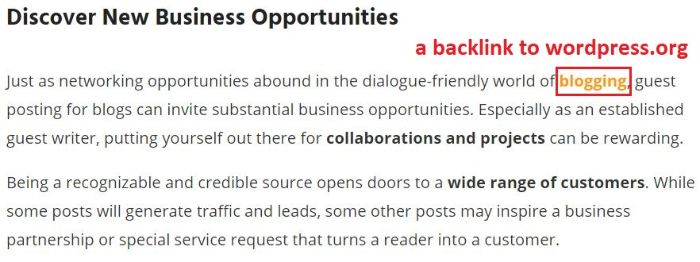
How Does A Backlink Work?
Backlinks are created when one website (i.e. a referring domain) links to another website by mentioning it on one of its pages (usually by placing a contextual hyperlink within relevant content).
Websites transfer value by linking to each other. Think of backlinks like trust signals or citations for web pages.
A backlink is made of a URL with anchor text (clickable text) that describes the content the URL is linking to.
Backlinks can be placed in many positions throughout a website or on the web. For example, a backlink can be placed within the main content of a blog post so that it can signal to Google that the external page it’s linking to may have contextual relevance.
Quality backlinks will have natural and contextual anchor text that blends into the content and doesn’t appear manipulative or fake. Visitors are more likely to follow a link if they believe it will take them somewhere useful.
As a visitor, you simply click on the anchor text and you’ll be directed to another web page. This means you’ve been referred to the web page by the backlink you clicked on.
The way backlinks work for ranking is mainly through establishing relevance and passing domain authority (or power) from the referring domain to the receiving site. If the referring domain is valuable or highly ranked by Google then some of that value will be passed through the backlink.
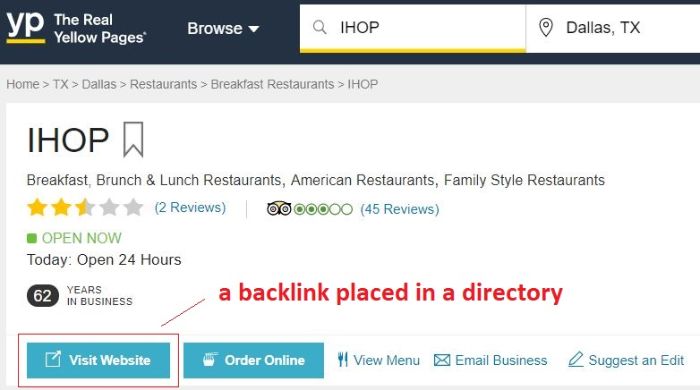
How Does Google’s Algorithms Read Backlinks?
So how do Google algorithms work?
Google obtains info from a variety of sources, such as:
- Web pages
- Book scanning
- User-submitted content
- Public databases & directories
- And much more
There are basically three procedures that Google algorithms follow during the process of finding and reading backlinks.
Crawling
The first thing they do is discover what exists on the web. Google needs to continuously search for new pages with automated web crawling bots. These bots are tasked with finding new pages and adding them to a list of known pages.
Some sites have been crawled before and others are newly discovered when crawling bots follow an outbound link from one page to another (this is when they discover backlinks).
When the crawler is scanning a web page it tries to find everything that’s on it like text and non-text content, visual layout, URL hierarchy, etc. This leads to the next step called indexing.
Indexing
Google’s Search Index contains all the webpages it has crawled on the web. Like an index in the back of a book, it contains an entry for every word on every web page. When a page is indexed, it’s added to all the entries for all words it contains.
Indexing is the process of figuring out what a website is about after it’s been discovered. Google analyzes the website’s content and catalogs media like text, images, and video.
Google’s algorithm is also analyzing the quality and relevance of linked pages (including external links). All this information is stored in Google’s index database for categorization and referencing.

Ranking
You need to be indexed before ranking well in the SERPs. Your website is like a book in a library and Google needs to know how to properly assess and refer to your site, and its content, in order to better serve its search engine users.
Also consider the analogy of how bookstores will put the most popular, trendy, or critically acclaimed books at the front of the store so shoppers see them first.
The most relevant and highest quality indexed pages will be “served” to search engine users first (i.e. get ranked higher in the SERPs for a given keyword).
During the overall process of crawling, indexing, and ranking, Google algorithms are discovering, following, and analyzing backlinks in order to index and rank web pages in the best way they see fit.
How Does Google’s Algorithms Favor Backlinks?
So you know the basic process of how Google discovers and delivers web pages to search engine users. But what do Google algorithms actually look for when assessing the quality of a backlink?
Simply put, Google algorithms look for quality and naturalness these days.
They look for quality backlinks that have authority and relevance. In other words, links that weren’t auto-generated or acquired from shady or spammy website niches. Links that send actual users from relevant sites to valuable and useful content.
There are actually hundreds of ranking factors that determine the quality of a backlink. Some of the most important, such as the Holy Trinity of Authority, Power, and Relevance are discussed in the following sections.
But it’s worth considering some other backlink ranking factors that Google algorithms take into account when liking a backlink:
- Links from Authoritative Domains: Google algorithms look favorably on backlinks coming from authoritative TLDs like .edu and .gov websites.
- Authority of the Linking Page: backlinks coming from authoritative web pages are liked by Google and transfer value to the pages they link to.
- Domain Age: links from aged domains may be more powerful than those on newer domains.
- # of Referring Domains: the total number of referring domains (i.e. backlinks) one website receives is an important ranking factor for Google’s algorithms.

- Contextual Links: backlinks that are embedded in useful and relevant content are considered more valuable.
- Backlink Anchor Text: having natural anchor text with keywords sends a strong Relevance signal to Google.
- Editorial Links: these types of backlinks are highly favored by Google’s algorithms.
As you can see, there are many different ways that Google will like backlinks (this is not an exhaustive list and there are many more factors).
Why Backlinks Are Important For Your SEO Campaign
Remember that SEO is basically about trying to make web pages as visible as possible to search engine users. Backlinks signal a vote of confidence in your website from other sites. They help search engines assess how relevant and authoritative a website is for a given topic or keyword.
If you get more links to your site from referring domains, then Google will determine that your website may be valuable and worth delivering to the SERPs.
In the past, the number of backlinks used to be a strong ranking factor. Now algorithms are becoming more sophisticated and capable of drawing on hundreds of factors to determine the overall quality of a backlink.
Quality backlinks are, in essence, links that send users to the most relevant and useful information. So the more quality backlinks you can get to your website, the more useful your website appears to Google, and the more likely it will rank higher in the SERPs.
Google wants to showcase the best and most trusted websites for a given topic and backlinks are crucial for giving Google the information to determine whether a site is valuable and trusted.
This is part of the reason why the quantity and quality of backlinks pointing to a website is a legitimate concern for SEOs and webmasters who are aiming to rank their sites as high as possible.
What Types Of Backlinks Are Valuable?
Before we discuss some of the specific types of backlinks you should consider getting for your site, it’s important to understand that the main SEO strategy is to create a strong link profile that’s composed of a diverse set of quality links. This concept is called link diversity.
Link diversity is when you use a variety of backlinks in order to create a naturally random footprint that Google’s algorithms won’t be able to track and penalize. Link diversity also helps with the ranking process by removing roadblocks.
It’s too risky to ignore link diversity by simply acquiring a bunch of similar links. Google will most likely discover such a predictable pattern and penalize your domain for it. The best practice for ensuring success is to utilize backlink diversity for long-term protection.
The randomness of a diverse link profile is defined by having backlinks coming from a wide variety of sources, positions on linking pages, types of sites, power levels, ages, and quality of sites.
Link diversity is also characterized by having backlinks that are randomly distributed over the three Holy Trinity Factors: Authority, Power, and Relevance.
A quick summary of these factors is as follows:
Authority
Authority is like the overall strength of a domain’s backlink profile. Think of all of the different types of backlinks pointing to all the pages throughout the website.
A backlink with high domain authority will obviously come from an authoritative website that already receives a lot of trust because it’s getting a lot of backlinks from many referring domains.
Those trust signals, or authority, will get passed to your site through the backlink.
Power
Power is like Authority except that it refers to the strength of a single web page. Think of all of the different types of backlinks pointing to a particular page on a website. A backlink coming from that particular page may be more powerful than one coming from a page with very few backlinks pointing to it.
Not all web pages on a site are equal and some are simply more valuable than others (like when they have relevant or quality content). A page is powerful when it receives a lot of quality backlinks and that authority can be transferred to your website through a single powerful backlink.
Relevance
Google puts more value on relevant links because reasonable (or rational) users are more likely to click on them to obtain relevant information. There’s an algorithm that assumes that “reasonable” web surfers will click on relevant links.
You want to make sure your backlinks are coming from the most relevant web pages possible. You also want to make sure your on-page SEO reflects the relevance of the websites sending you the backlinks and the search interests of your target audience.
Although there are dozens of backlink factors that help with ranking, as discussed in the previous sections, these three concepts are some of the most important for determining the quality of a backlink. The quality of many of the different types of backlinks out there can be assessed using these three factors.
Specific Types of Backlinks
Keeping the idea of natural randomness in mind, your backlink profile doesn’t need to acquire a lot of each Holy Trinity factor (although some of the biggest domains have a ton of each). The less of one factor a link contains the more of the other two it should have.
For example, a quality backlink can be high in authority but low in power and/or relevance. Likewise, it can be high in relevance but low in authority and/or power.
Now let’s take a look at just some of the types of backlinks that are considered valuable with respect to link diversity and ranking:
DoFollow Links
Many links on the web are dofollow links. Dofollow is the default SEO attribute for most URLs. If you create an outbound link to another site, it will automatically be set as dofollow.
Dofollow links are valuable for link building because they count towards search engine ranking in most cases.
NoFollow Links
The nofollow attribute (another type of metadata) was designed to deal with the problem of excessive spamming in the past (like self-promotional links in blog comments). You’ve seen them before and you probably see them today. These types of spam links bring little value and detract from the overall experience of web surfers.
You can add some HTML to a hyperlink code to make it nofollow. This will signal to Google that the nofollow link shouldn’t be given any weight for ranking. It’s telling Google to ignore the link because it adds no value.
Regardless of the low quality of nofollow links, you need to make sure to maintain a balance of dofollow and nofollow links because this makes a site appear natural.
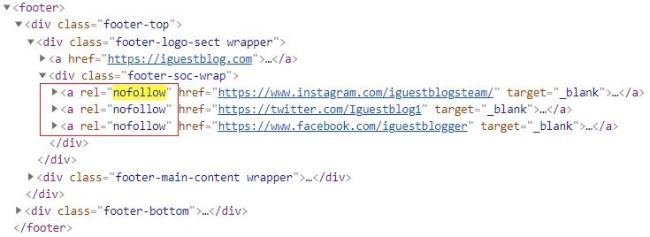
Pillow Links
One of the best ways to add naturalness and diversity to your profile is with pillow links. Although they don’t provide much raw ranking power (unless you’re targeting a low competition niche), they’re important backlinks that offer insulation and padding for other link building efforts.
Pillow links should be used to buffer your website in the beginning and throughout the ranking process. Pillow links include such specific backlinks as forum posts, social profiles, citations, dofollow, and blog comments.
Authority Links
In contrast to pillow links, we consider authority links as strong backlinks that supply the raw ranking power, authority, and relevance factors that can really boost a website in the SERPs.
Authority links are almost always dofollow. Examples include niche edits, guest posts, PBNs, and editorial links.
Contextual Links
Contextual links appear in paragraphs of text (or the body of main content) instead of other ancillary web page positions like a menu, widget, or sidebar.
Contextual links draw on the relevance of the information surrounding them. Authority links are usually contextual links.
Guest Posts
A guest post is a high-quality link that can help your rankings a lot. They are relevant, contextual, authority links. It’s one of the most popular and effective ways for building backlinks.
Guest posts (or blog posts) are created when a webmaster makes an agreement with an author/content writer that permits the author to publish a useful piece of content on the webmaster’s blog.
The content provider benefits from guest posting by receiving a contextual backlink on the blog to her website.
Niche Edits
Also known as curated links, niche edits are contextual authority links placed into relevant, pre-existing articles.
Niche edits are similar to guest post links except that niche edits are placed into aged articles that may have pre-existing links pointing to them. Guest posts are brand new articles without a pre-existing link profile.
PBNs
PBNs are contextual, authority links on the homepage of blogs that are geared towards manipulating search results. Typically these blogs are domains that are reused for passing power and link juice to target sites.
For example, old or expired domains with a diverse backlink history can be repurposed when you want to link and pass power from their homepage links to money sites.
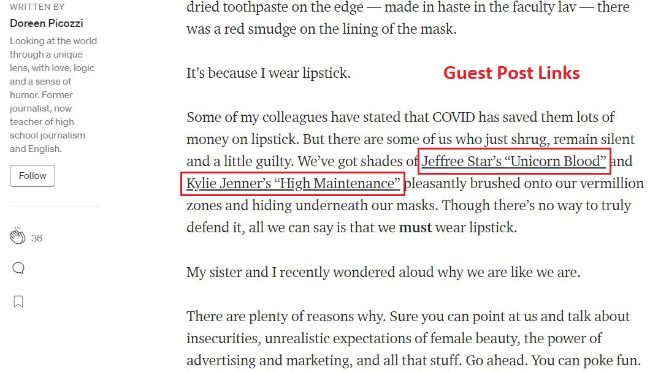
Editorial Links
Editorial links are usually part of relevant content that’s commissioned or prepared for publication on high domain authority sites. They’re essentially like guest posts but more expensive and much harder to obtain.
Editorial links are authority links because they’re typically associated with news publishers or other highly authoritative, trustworthy websites.
Blog Comments
Blog comments are pillow links that help with diversifying a link profile. To get a blog comment you simply need to comment on a blog post and leave your website link in the details. Your name can be used as the anchor text to link to your site.
Directory Links
Directory links can be found in web directories like catalogs and online lists. Posting directory links is a decent content marketing tactic to naturally spread your brand in niche markets while adding pillow links.
Citations
Citations are great pillow links because they’re natural, free, and relevant to target niches and locations (depending on the directory they’re listed on).
Citations are similar to niche directory links except you can add your name, address, and phone number (NAP) along with your website link.
Social Signals
These social media metrics signal popularity of specific content. Examples of social signals are shares, likes, views, and comments. You’ve seen these across various social platforms.
Using social signals for building backlinks is about increasing trust and naturalness because it’s very common for popular websites to be discussed and shared on social media platforms.
Blogroll Links
A list of published blog posts is called a blogroll. Usually, a blogroll will show preview text of each published blog post (like the first paragraph) in chronological order.
A blogroll link is simply a link that’s placed in that preview text so users can immediately see it when they’re scrolling through the blogroll.
Sometimes a blogroll will show the entire blog post in which case you’ll only need to get a link placed anywhere in the article.
Links pointing to any page can also be placed in the sidebar of a blogroll as shown in the following image:
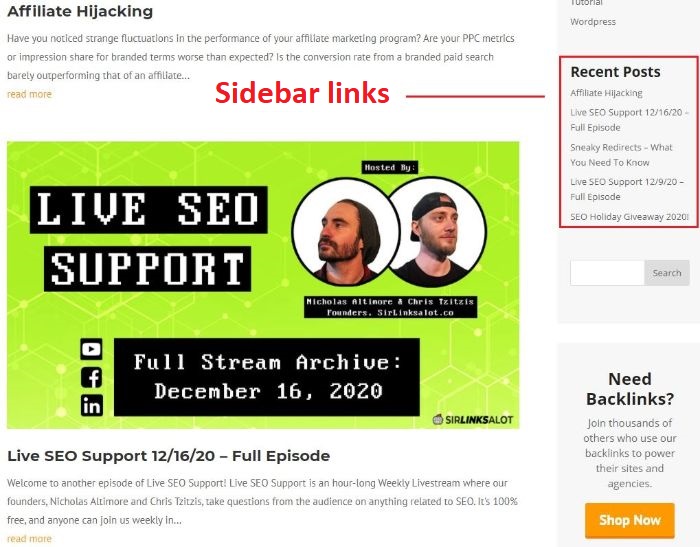
Resource Pages
These types of web pages display useful resource links about a product, service, or topic. They are created to offer additional resources for visitors to learn more about their interests.
You can build backlinks on resource pages by contacting a webmaster and requesting for your links to be included on the resource pages.
Sitewide Links
Sitewide links are simply backlinks placed on most or all web pages of a domain. They can be placed in various sections that are replicated across all web pages like the header, footer, body, or sidebar.
Because they may appear on every page of a website, a huge site could generate hundreds or thousands of backlinks.
The Dangers of Backlinking
Not all backlinks are good for you, believe it or not. Sometimes backlinking can be dangerous and harmful to your SEO.
Since the dawn of search engines people have been using backlinks in shady ways to manipulate search engine rankings, and they still do.
Spamming irrelevant links is one of the biggest red flags when it comes to backlinking. Especially links that just try to direct users to buy random products or redirect them to pages they don’t want to visit.
Auto-generated links are a form of spam links that offer very little value and diminish the user experience of web surfers. Duplicating content with the same backlinks on multiple websites is another bad practice.
You also don’t want to acquire too many bad links from low domain authority sites or shady niches. Quality is always better than quantity.
It’s really just common sense, but you need to focus on building high quality backlinks from trusted websites that link to and from great content if possible. Associating with spammy websites and building low quality links will only hurt your SEO.
This is when it helps to understand what a good amount of backlinks for a website should be as well.
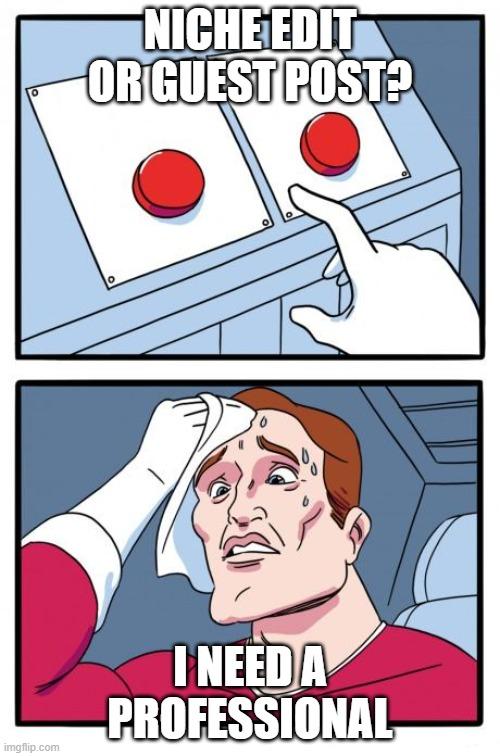
Where To Get Quality Backlinks For An SEO Campaign
Now that you understand the importance of backlinks, what are some safe and effective ways to get backlinks for your SEO campaign?
Well, as we’ve said many times, you’re going to want to focus on quality over quantity. Don’t just assume that getting as many backlinks as you can from any source is the easy way to proceed.
Trivially increasing the number of backlinks used to work in the past, but algorithms are way smarter these days. You need a diverse mix of natural and quality backlinks that revolve around great content and come from as many trusted, relevant sites as possible.
There are basically four ways to get links to your site:
Earn them
This is the most natural or organic way to get links because it’s when other people find your content through Google, social media mentions, or word of mouth, and voluntarily link to your pages.
Create them
This is when you’re manually adding links on other websites that point to your pages (e.g. directories, blog comments, forums).
Build them
Link building takes effort and you’ll need to reach out to webmasters, editors, site owners, and business owners and persuade them to link to your pages by showing that you can add value and that your website is worth linking to (e.g. guest posting, relevant content, unlinked mentions, broken links).

Buy them
You can buy a variety of links from link building specialists who can target them based on your specific needs or link building strategy.
Here are some examples of each:
Post content in your blog section
Posting articles in your blog section with informative and engaging content that showcases your expertise is one of the best ways to share link-worthy content on the web.
Answer questions with resource pages and FAQs
People surf the web to learn things and ask questions. Information resources can be very useful pages for linking back to regarding complicated topics or niche products.

Make shareable content like infographics and memes
Infographics, memes, and videos are some of the most shareable content on the web. You can potentially get hundreds of links if any of them go viral on social media.
Comment on blogs
Posting useful and relevant information in blog comments is a natural and free way to link back to your site.
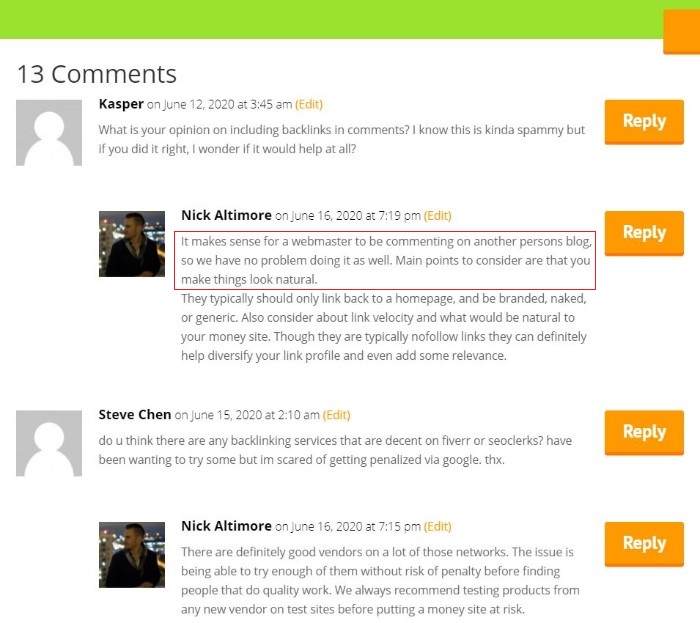
Submit your website to forums, directories, and social profiles
A great way to build a reputation and attract your target audience is to post your website in niche directories, social networking sites, and forums.
Guest blogging and editorial links
Publishing a guest post piece of content on powerful niche sites and content blogs is a great way to get link juice flowing to your site.
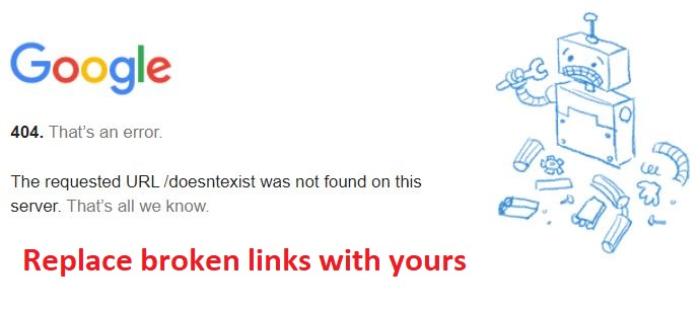
Broken link building and unlinked mentions
Broken link building is when you find a broken link and have it replaced with your working backlink. Finding unlinked mentions of your product or service and having them link back to your site is also a simple way to build links.
Buying powerful links from SEO professionals
Outsourcing to a professional is a very efficient method to plan your link building strategy and hit your target goals. You can get many types of quality backlinks this way without having to risk too much time and money.
Conclusion
Backlinks are a highly significant ranking factor because they signal a vote of confidence in your website. They are absolutely necessary for improving visibility in the SERPs.
It’s always best to aim for quality links that are authoritative and natural. Avoid spam, irrelevant, or auto-generated links from shady websites as much as possible. They will only do you harm.
The best backlinks will go a long way in helping to position your site on top of Google search results. Your organic ranking will improve as your pages receive more links from other strong websites that tell Google your site has valuable content that should be displayed to search engine users.
Backlinks naturally increase referral traffic to your website as various online sources start linking to your pages. This will help engage your target audience and boost your ecommerce business if you’re trying to build one.
Backlinks also help with getting your site indexed faster by Google web crawlers that follow backlinks to discover and rank web pages. It will take much longer to rank without incoming links (if you ever do).
Contributing Author: Brian Kihneman
 Article by:
Article by:
Nicholas Altimore
Hey I'm Nick, the Founder/Director here at SirLinksalot. I have a passion for building online businesses and taking websites to the next level with the help of my amazing link building team.
 Questions or Comments?
Questions or Comments?
We are active in our Facebook Group seven days a week and would love to hear from you. Ask us questions, learn from other group members, and share your knowledge.
Related Posts
Ready To Start Building Your Rankings?
Your link building journey to the top of Google starts today!
Apply for Managed Link Building to get a free analysis and game plan, or order backlinks a la carte.
Link building services that work.


